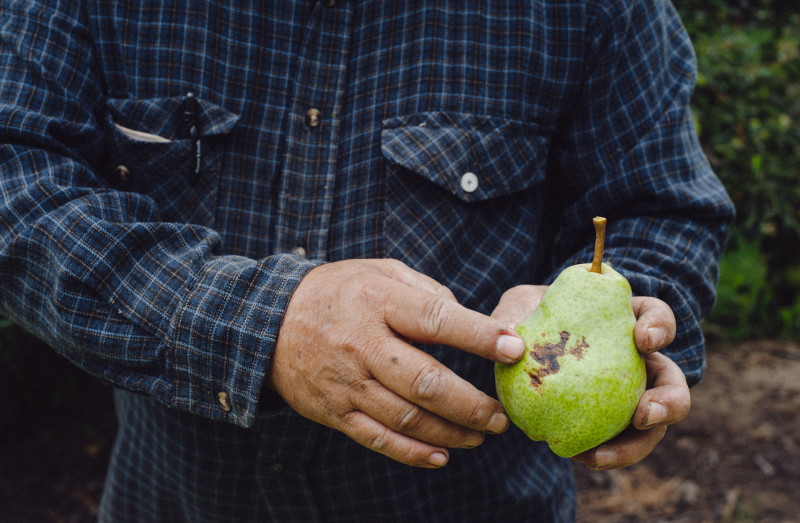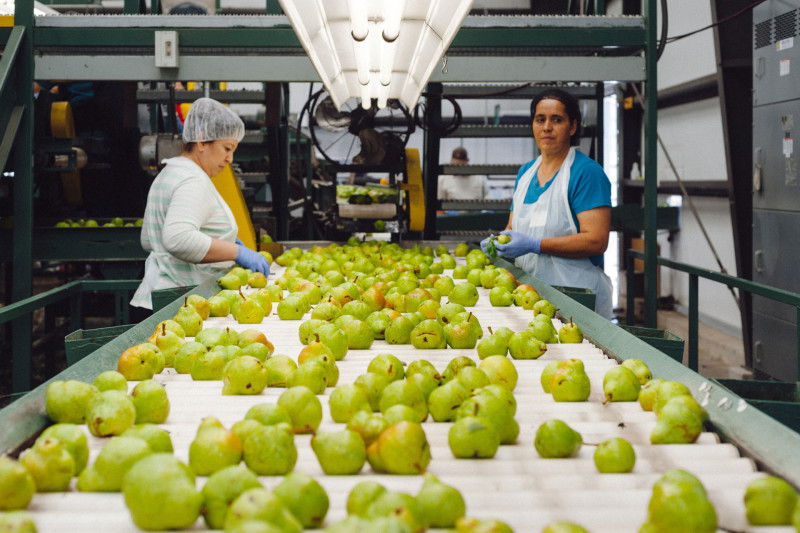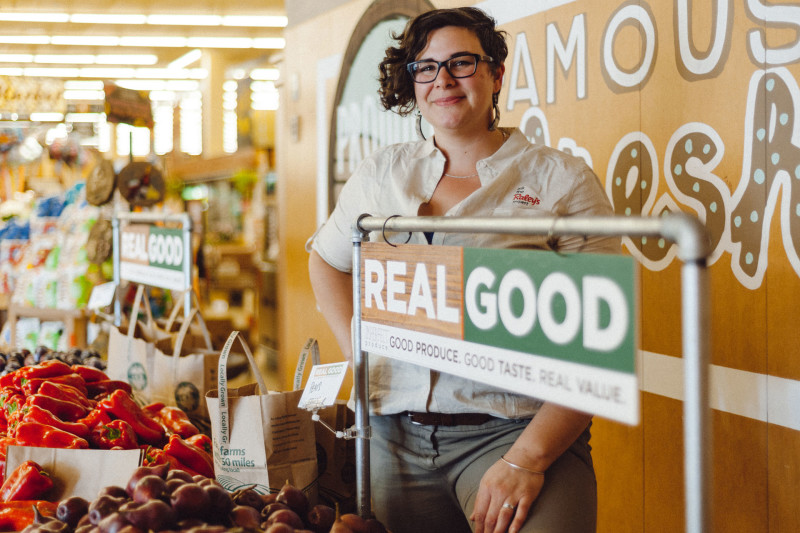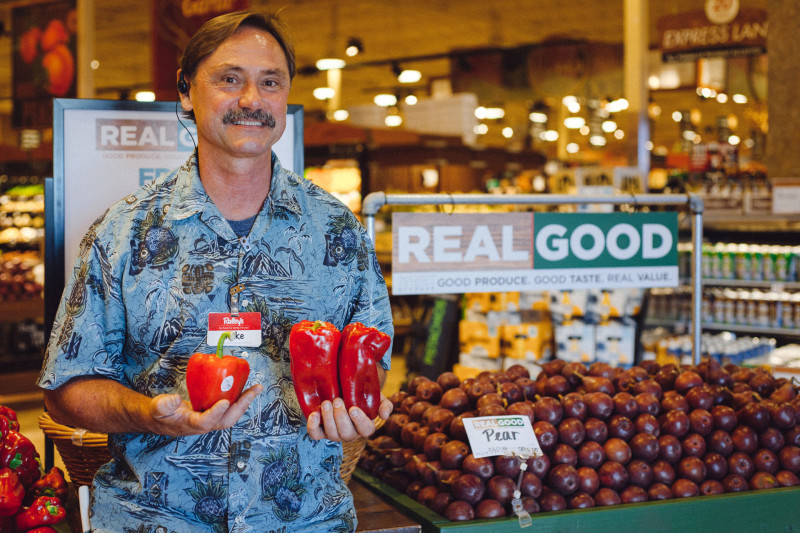Fighting
Climate Change and Food Waste With ‘Imperfect Produce’
SPONSORED
BY
If you
fit the public media stereotype, you probably pride yourself on caring about
the environment, right? Maybe you’re letting your lawn go brown, or trying to
drive less. Some experts say there’s another way you can be environmentally
friendly: Stop wasting food.
From
the farm to the fridge, it’s estimated that 40 percent of what could be eaten
just isn’t, and that can impact climate change.
To find
out more, I go to the Sacramento Delta, where pear season has just begun. I’m
talking to Chuck Baker, a lifelong pear farmer who manages a ranch for Rivermaid Trading Co., and I’m trying to
stay out of the way of workers literally running from tree to tree with ladders
picking the biggest pears.
“We
have a lot of wind in the delta,” Baker says. “That’s why we have very good
fruit, because of those cool delta breezes at night.”
However,
he says that helpful wind can also cause what’s called limb rub. He points out
a fat pear, with small marks on the skin.

An example of “limb rub” on an otherwise perfect pear. (Cynthia E.
Wood/KQED)
“This
is just from the wind swinging the pear against another pear or limb, and it
makes a mark,” he explains. “The industry in the past has set standards very
high, where they don’t allow those marks. A lot of that fruit has good value,
there’s nothing wrong with it. It’s just a little cosmetically challenged, like
all of us.”
As
workers dump loads of pears into bins on a tractor, produce broker Ron Clark
laments these standards.
“It’s
not just in our food, it’s in our lives,” he says. “We have a lot of images
sent to us of thin models, perfect-looking Hollywood faces. But that’s not
reality, is it?”
‘There’s nothing wrong with it. It’s just a little cosmetically
challenged, like all of us.’Chuck Baker
Clark
is co-founder of a new startup called Imperfect Produce, which
is working to change consumers’ perceptions and find homes for “cosmetically
challenged” produce. They’re starting with low-cost CSA boxes and a grocery
store partnership (more about that at the end of this story). He takes me to a
nearby packing shed, where the fruit gets washed and then sorted by lines of
women quickly separating imperfect pears from marketable ones, which get
hand-wrapped and packaged.

Workers sort pears at the Rivermaid Trading Company packing shed in Lodi. (Cynthia
E. Wood/KQED)
“Twenty
percent of fresh produce that’s grown for the fresh market never makes it to
human consumption,” Clark says. That means it doesn’t make it onto grocery
shelves, or in canned products, or even juices. “It either gets plowed back
into the field, composted or ends up in landfill.”
So,
what’s the big deal about food waste? Jonathan Bloom, author of “American Wasteland,” says, “We’re
basically aiding climate change from the food we throw away.” First, there’s
water, certainly among the hottest topics in California. “About one-quarter of
fresh water usage is embedded in food that is ultimately thrown out,” he says.
Then there’s
oil. “There’s a tremendous amount of oil that goes into producing our food,”
Bloom says. The best estimates he’s seen are that 4 percent of all U.S. energy
consumption is used to produce food we don’t use — energy for on-farm tractors,
transportation and refrigeration.
All the
wasted food goes to the landfill, and it decomposes without air, creating
methane, says Bloom. While there are lots of questions about how to
definitively and consistently collect data relating to food waste, Bloom says,
“What we do know is that the two largest creators of waste are farms and
households.”

Meg Burritt, director of wellness and sustainability at Raley’s.(Cynthia E.
Wood/KQED)
Enter
Meg Burritt. She’s the director of wellness and sustainability for the grocery
store chain Raley’s, which has over
100 stores in Northern California and Nevada.
“There
are a couple of problems that I think we as grocers haven’t addressed in our
history as an institution. One of them is food waste,” she says.
Another
is helping people on a budget access enough nutritious produce. She didn’t know
exactly what part Raley’s could play, until last fall when she saw acatchy video produced by French
grocer Intermarché, in which the store specifically marketed “ugly
produce.” The video went viral, and Intermarchéreported spectacular sales.
A similar program started in a huge Canadian chain.
“I’m an
optimist, so I thought: Well, they’re doing it in France, they’re doing it in
Canada, we can definitely do it here in the States,” says Burritt.
Four percent of all U.S. energy consumption is used to produce
food we don’t use
Raley’s
has partnered with Imperfect,
and just last weekend they launched a pilot program in 10 California stores.
They targeted neighborhoods where customers may have tighter budgets, or where
there aren’t a lot of options for buying produce.
I visit
a Raley’s in the Gold Country town of Auburn. The display of what they’re
calling Real Good
produce is just steps from the door, and it’s piled high with
pears and bell peppers. Regular customer Rich Purdom gravitates toward the
bright red elongated peppers.

Mike Selepec, produce team leader at Raley’s, holds a $2 “perfect” red pepper
next to two “imperfect” peppers, which sell for $1.19 per pound. (Cynthia
E. Wood/KQED)
“I go
by color when I buy vegetables,” he says.
I point
out that the prices are lower — about 75 cents each, compared with $2 for a
regular pepper — because of how they look.
“Funny-looking?
That doesn’t bother me,” he says. “They’re going to get chopped up in fajitas.
It all ends up in the same spot, right?”
Kate
Johnson makes a beeline for the pears, which she’s loading into a paper bag.
She’s been shopping here 35 years, and read about the Real Good produce program
in the newspaper.
“They
mentioned they’re going to use fruit you may not usually buy because it’s a
little smaller or a little blemished,” she says, “but we know it’s perfectly
all right.”
When I
say that not everyone knows that, she laughs. “Well, they should be a little
more informed!”
The
pilot program will last about 90 days, starting with pears, plums and red and
green peppers and then moving to other produce. If the Auburn store is any
indication, it’s going well so far. It has sold more imperfect produce than
expected in the first week.
No comments:
Post a Comment